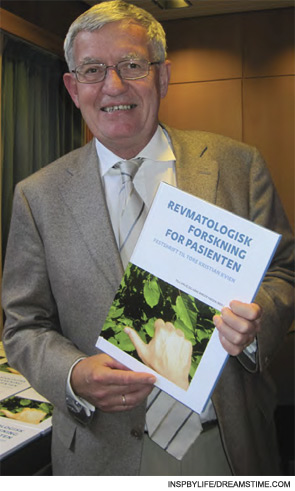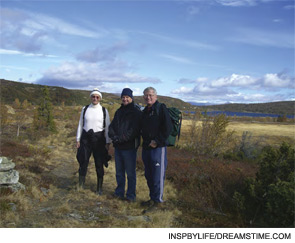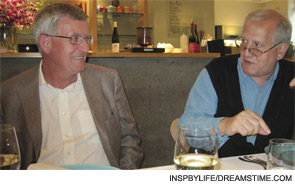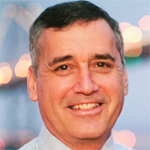I have become quite a different doctor than I had imagined I should ever be,” reflects Tore K. Kvien, MD, PhD, professor of rheumatology at the University of Oslo, head of the department of rheumatology at Diakonhjemmet Hospital in Oslo, Norway, and past president of the European League Against Rheumatism (EULAR).
In a recent telephone interview, Dr. Kvien reveals he originally planned to become a family doctor. But even when he gravitated to rheumatology, his initial vision—to become a good clinician—has informed his leadership in his chosen specialty. Throughout his career, Dr. Kvien has devoted his scientific intelligence to advancing patient care. With nearly 300 scientific papers recorded in PubMed and leadership roles in major national and international rheumatology organizations, he has won renown for establishing his country’s first longitudinal patient database, for conducting wide-ranging collaborative research, and for fostering productive international initiatives.
The First Road
Dr. Kvien knew that medicine was for him even during his teenage years, he recalls. Diligent work and support from his parents helped to make that dream come true. Shortly after obtaining his medical school certification, he says, “I wanted to have some hospital practice, because that was relevant to becoming a family doctor.” He also knew that musculoskeletal diseases comprised the most frequent problems for which patients sought medical care, so he chose to train at Sørlandet Rheumatism Hospital from 1976 to 1978. During that time, his interest in the general practice of medicine morphed into a fascination with rheumatology. He subsequently spent four years at Oslo Sanitetsforening Rheumatism Hospital, the last 10 months of which were as head of the Pediatric Rheumatology Department.

While there, Dr. Kvien was under the tutelage of pediatric rheumatologist Hans Martin Høyerall, MD, PhD, who gave him the opportunity to take responsibility for an industry-independent randomized controlled clinical trail program in juvenile arthritis. This work formed the cornerstone of Dr. Kvien’s PhD thesis, “Drug management of patients with juvenile rheumatoid arthritis.”
To become a rheumatology consultant required additional training, which he acquired in the departments of medicine, cardiology, nephrology, and neurology in various hospitals in Oslo during the following year. Dr. Kvien then accepted a position as a rheumatology consultant at Diakonhjemmet. His experience with a spectrum of clinical practice offered opportunities in his new position for collaboration between rheumatology and other disciplines, such as nephrology.
From his first experiences seeing patients with rheumatic diseases, Dr. Kvien had observed a lack of evidence for clinicians’ treatment decisions. He determined that, if he were to go into research—as he had been encouraged to do by his mentor—“it should be something relevant for clinical practice,” he says. He felt it would be crucial to “extrapolate research findings into improvement of patient care.”
Building on Lessons
Since the 1980s, Dr. Kvien had been aware of and was intrigued by the work of U.S. and Canadian researchers who were collecting quantitative data from clinic patients (through instruments such as the Health Assessment Questionnaire and Visual Analog Scale) and storing these in longitudinal databases. Along with other Scandinavian rheumatologists, he had attended an Arthritis, Rheumatism, and Aging Medical Information System (ARAMIS) meeting at Stanford University in Stanford, Calif., in 1987 and returned to the U.S. in 1991, visiting first with Ted Pincus, MD, who was then professor of medicine and microbiology at Vanderbilt University School of Medicine in Nashville, then with Fred Wolfe, MD, in Wichita, Kan., and the collaborative research group in Salt Lake City.

“There were very few of us actually collecting data from our patients,” notes Dr. Wolfe, medical and research director of the National Data Bank for Rheumatic Diseases and clinical professor of medicine at the University of Kansas School of Medicine in Wichita. “We had some ideas, from our experience, of what was easy, what was difficult, what was valid and what wasn’t, and which data should be collected,” recalls Dr. Wolfe. “And Dr. Kvien, surprisingly, went away believing us!” he chuckles.
Dr. Kvien returned to Norway with great enthusiasm for what he had learned from that trip to the U.S., and became, in Dr. Pincus’ words, “an early adapter” of their methods. He established the Norwegian branch of the European Research on Incapacitating Diseases and Social Support (EURIDISS) cohort in 1991 with “early” rheumatoid arthritis (RA) patients (less than four years’ duration); these patients completed their 15-year follow-up in 2007. One study, led by his first PhD trainee, Liv Marit Smedstat, MD, PhD, tracked the relationship between psychological distress and traditional clinical variables in a two-year prospective study of 216 patients with early RA. That study found that psychological variables were important in the prognosis and description of patients’ conditions, which is similar to results shown by Drs. Pincus and Wolfe.

The Oslo Rheumatoid Arthritis Register was established in 1994. Dr. Kvien expanded upon the methods he learned from Drs. Pincus and Wolfe, adding other variables and making these data available for epidemiology studies and population surveys. For example, it was not possible to establish a national register of patients treated with biological agents in Norway. However, together with four other hospitals in Norway, the NOR-DMARD study was started in 2000. “We realized that we would never be able to reach the level of the big registries, but we built an alternative focus on both biological and synthetic DMARDs [disease-modifying antirheumatic drugs] and including all inflammatory arthropathies. In this way, NOR-DMARD has provided some important information that is complementary to other and larger registries,” notes Dr. Kvien.
The register has provided a fertile seedbed for a large number of research efforts, including outcomes research in osteoporosis and cardiovascular sequelae; establishment of cohorts of ankylosing spondylitis patients; and, in 2002, establishment of a new cohort of early RA, which has been followed with a special focus on MRI findings.

Most recently, his group contributed data from their early arthritis patient cohort to the EULAR/ACR Task Force that just released its new criteria for diagnosis of RA. Maria D. Mjaavatten, MD, a PhD candidate who is working on prediction of persistent arthritis and RA in very early arthritis patients, notes: “We are now talking about this ‘window of opportunity’ to try and catch people at risk of developing RA earlier.” Such work would not have been possible without access to the exhaustive work spent tracking patients over time. This Norwegian very early arthritis clinic (NOR-VEAC) study has included more than 1,000 patients with arthritis of less than 16 weeks’ duration—quite a shift, notes Dr. Kvien, “from the early 90s, when we defined ‘early’ RA in EURIDISS as up to four years’ duration.”
Intentional Leadership
When he became head of rheumatology at Diakonhjemmet in 1994, Dr. Kvien noted that the department’s small size and containment within a smaller hospital translated to an advantage: The department could grow without having to strive too much against competing departments, which is often the case at bigger hospitals.
Known for his modesty, Dr. Kvien states, “I have been fortunate to be the right person at the right time and have been given some opportunities.” Colleagues and trainees attribute the growth of their department to Dr. Kvien’s astute leadership. Espen Haavardsholm, MD, PhD, a senior researcher in the department, says of his former mentor (and now colleague): “He is very visionary. He wants the department to do high-quality research, and he has some well-thought-out strategies on how to develop the organization.” One of those strategies appears to be recruiting researchers while they are still in medical school. According to current and former trainees, Dr. Kvien’s practice was to offer them positions as research assistants when he met them during their medical training. “There has been a big development in our group in the last 10 years, ” notes Dr. Haavardsholm. “Several of the students have received their PhDs, and we now have quite a few at the postdoctoral level as well.”
Dr. Kvien is very passionate that we should not sit in our own department and hold onto our own data—we should seek opportunities to collaborate with other groups, especially research groups that are at a higher international level.
Glenn Haugeberg, MD, PhD, who did his original PhD work in Dr. Kvien’s lab in 1995 on generalized osteoporosis in RA, is now a professor of rheumatology at the Norwegian University of Science and Technology in Trondheim, Norway. Of Dr. Kvien’s training program, he says, “Tore has been very strategic and very clever at building up this research department. This has only been possible because of both his brilliant human skills and his dedication to research.”
Egalitarian Collaboration
Pernille Bøyesen, MD, a current PhD candidate who has known Dr. Kvien since she was a medical student, agrees that the department is outstanding. “In addition to his scientific qualities, Dr. Kvien also has a high social intelligence,” she notes. “He is really good at lifting people up and encouraging them to do things that sometimes they didn’t think were possible for them. “We don’t have a hierarchical system here [in the department]. Whether you’re a student just taking courses, or a doctor, nurse, or physiotherapist, we are all on the same level. I think it’s important for Dr. Kvien that we all talk together in the same language. We are used to being open minded and to saying what we think.”
The egalitarian view extends to collaborations with colleagues, says Dr. Haavardsholm. Dr. Kvien “is very passionate that we should not sit in our own department and hold onto our own data—we should seek opportunities to collaborate with other groups, especially research groups that are at a higher international level.” Dr. Mjaavatten adds: “He’s not been reluctant to collaborate with people or groups who are more accomplished in certain research fields than we are, because that’s the way you improve. And of course, collaboration has also been necessary, coming from a small country like Norway. But he is very welcoming of all kinds of ideas.”
Career Timeline
1974 – Earns his MD from Oslo University
1978 – Completes a residency at Sørlandet Rheumatism Hospital
1982 – Completes a residency at Oslo Sanitetsforening Rheumatism Hospital
1984 – Completes cardiology residency at Rikshospitalet, The National Hospital
1986 – Completes neurology and nephrology residencies at Ullevål University Hospital
1986 – Earns his PhD from Oslo University
1986 – Becomes consultant rheumatologist at Diakonhjemmet Hospital
1994 – Becomes head of rheumatology at Diakonhjemmet Hospital
2005 – Serves as president of EULAR
2008 – Becomes editor of the Annals of the Rheumatic Diseases
Looking Forward
Currently, Dr. Kvien nurtures his own research interests, which include longitudinal studies on RA in Oslo, focusing on health status measures, osteoporosis, and other disease manifestations; early arthritis and predictors of long-term outcomes; health service research; biomarkers and imaging modalities; and patient perspectives in outcomes research (activity in OMERACT has been part of this interest). In the latter work, his wife Turid Heiberg has also been an active collaborator and contributor to the research. “I have also been fortunate to work together with my wife in research activities,” he says. “We have traveled together to many meetings around the world.”
When asked about the progress and future challenges for his field, Dr. Kvien applauded the huge developments in understanding inflammatory joint disease mechanisms and individualization of treatments, as well as access to new drug therapies. It’s now time, he says, to “make those same steps in the right direction with degenerative joint diseases as we have done with the inflammatory joint diseases. In osteoarthritis, we are many years behind.” And yet, he remains optimistic: “I see more opportunities than I see threats.” That kind of statement is emblematic of Dr. Kvien, says Dr. Haugeberg: “He always looks at opportunities, and not limitations. The word ‘problem’ does not exist for him.” To address the challenges in osteoarthritis, Dr. Kvien’s group also started a longitudinal study of hand osteoarthritis about seven years ago. “Osteoarthritis is a field where we will see an increasing focus from our group in the coming years,” he predicts.
Finding leisure time might be the only drawback in his busy life. Dr. Kvien and his wife enjoy spending time in their cabin in the mountains, hiking, fishing, and skiing. But as a past president of EULAR; current member of its Scientific Committee; and editor of the organization’s journal, Annals of the Rheumatic Diseases, Dr. Kvien keeps an active travel schedule. But this traveling is also interesting and fun, he says. “The strength of European rheumatology is the strong friendship between leading rheumatologists. It has been a pleasure also to follow the growing collaboration between ACR and EULAR.”
Tore Kvien has fostered long-time friendships in the rheumatology community. “Meetings in the area of rheumatology usually mean that you will have a good time, combined with good science and the opportunity to bring new information back to the clinical work and to the researchers.”
Dr. Haugeberg says that he values the ways in which Dr. Kvien fosters a productive work atmosphere. “Often, in research, you can become so focused on results that you may forget to see the human being. The joy of working with him is that you feel that you are respected. I learned a lot from that perspective.”
Dr. Wolfe puts it this way: “There are two kinds of people who rise to the top of these organizations. Some compete as if it were a zero sum game. But that’s not what Tore Kvien does. He is happy when everybody succeeds.”
Gretchen Henkel is writing the “Profiles in Rheumatology” series.

